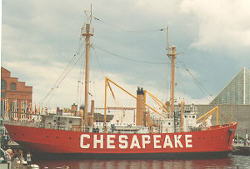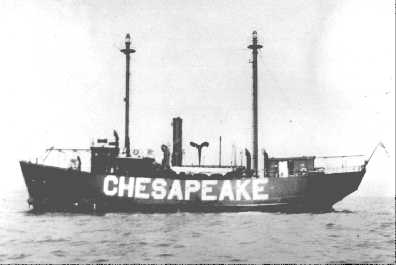

Lightships are an important part of navigational history. Anchored offshore in places
impractical to place stationary markers, they marked entrances to shipping channels and harbors.
With their bright red paint, duty stations painted on the sides in tall letters, and beacon lights
on the mast, they were easily identified by approaching shipping. Today they have been
largely replaced by automated towers or bouys.

Chesapeake was built in 1930 in Charleston, South Carolina. Her first duty station was Fenwick Island, Delaware. In 1933 she moved to the mouth of the Chesapeake Bay. She is shown in the picture at right (taken by Jim Flanders) at that location, sometime between 1950 and 1952. She served there until she was replaced by a platform light in 1965. In 1966 she moved again to the mouth of the Delaware Bay, taking the name Delaware. In 1970 she was again replaced by an automated light. In 1971 she was decommissioned and transferred to the National Park Service to serve as a floating environmental laboratory on the Potomac River, near Washington, DC. She served in this capacity until 1981, when the City of Baltimore took posession and opened her to the public. She is moored beside the National Aquarium, along with the submarine USS Torsk (SS-423), and the Coast Guard Cutter Taney (WHEC-37).
Some Statistics:
Length: 133'3"
Beam: 30'
Draft: 12' forward, 13'9" aft
Displacement: 630 tons
Main propulsion: Diesel, 350 hp
Max speed: 9 kts
Crew: 16 Officers and enlisted